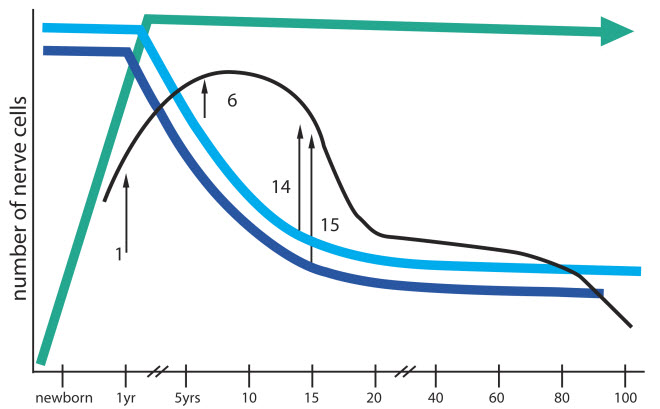The Science of AD(H)D
Evolution of the Brain & ADD/ADHD Symptoms
At the time of birth, a newborn infant has an enormous number of brain cells, which continue to grow until age six years, and then recombine rapidly from the age of six to fourteen years. This process is called synaptogenesis or “pruning.” The brain wants to have fewer, but better connected, nerve cells. One theory holds that errors in this process could be the cause of the faulty Executive Function of individuals with Attention Deficit Hyperactivity Disorder (ADHD) and Attention Deficit Disorder (ADD).
The following graphic image illustrates the emergence of cognitive skills (curved line/height = number of neurons) and symptom clusters are represented by the solid lines. The ages of emerging Executive Function and Working Memory are indicated on the bottom line.
Age(s)
- 1 = the emergence of Working Memory (Inattention)
- 6 = planning, sustained attention, recognition memory skills emerge (Hyperactive/Impulsive Symptoms appear)
- 14 = Executive Function (Co-occurring ADD/ADHD disorders/ hyperactivity – impulsivity lessens/inattention persists)
- 15 = cognitive flexibility and inhibition, verbal memory
ADD/ADHD Medical Diagnosis
A standard medical resource that describes the patterns of thinking and behavior common to us human beings and logically organizes psychological disorders is The APA Diagnostic Manual (DSM-V, May 2013). Recently, the overall classification for ADD was changed from ADD to ADHD to reflect the higher proportion of the hyperactive/impulsive subtypes.
The current classification of ADHD with subtypes is:
- 314.01 Combined
- 314.00 Inattentive
- 314.01 Hyperactive/Impulsive
The basic criteria required for a diagnosis of ADHD are listed in the book, with a minimum number required overall and for the different subtypes: a persistent pattern of six months’ duration (often observable by age 12), and not due to another disorder (anxiety and mood disorders – especially bipolar) are critical.
How Science Views The ADD/ADHD Complexity
The concepts of Executive Function and Working Memory formulated by psychologist Russell Barkley have been critical to the development of methods to compensate for ADD/ADHD. Along with increasing public education, the emerging fields of coaching and Assisted Technology are significantly beneficial.
 The neurophysiologic and genetic pathways are revealing more information continuously. We know that the ADD/ADHD brain is smaller in an area critical to sustained attention: the role of stimulant medication is to supply the missing neurotransmitters. We continue to better understand the complex correlation of brain activity, cognitive function and behavioral manifestation. A recent article in Scientific American, Building Blocks of Memory: Brain Cells for Grandmother, February 2013 revealed a significant breakthrough in the concept of memory formation.
The neurophysiologic and genetic pathways are revealing more information continuously. We know that the ADD/ADHD brain is smaller in an area critical to sustained attention: the role of stimulant medication is to supply the missing neurotransmitters. We continue to better understand the complex correlation of brain activity, cognitive function and behavioral manifestation. A recent article in Scientific American, Building Blocks of Memory: Brain Cells for Grandmother, February 2013 revealed a significant breakthrough in the concept of memory formation.


